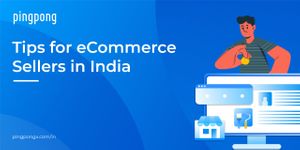
Tips for eCommerce Sellers in India.
In the entire span of living, a few years are always remarkable!
We have come a long way from the era of the popular television show, "I dream of Jeanie", where many dreamt of touching the grounds of countries like the USA to now carrying trade through online selling platforms. That is a transformation witnessed in more than 2 decades.
Today more than humans, businesses have crossed national boundaries. You can sell everything online and receive international payments seamlessly faster than you think.
In the meantime, when the world just got accustomed to untrodden trends of changing technology, soon life was struck with Covid-19. When things appeared falling apart in businesses, to everyone's surprise, a few segments where the pandemic triggered the turning point included digital payments and eCommerce.
Despite the lockdown, no one could alter the buying behaviour of the customers. Thanks to the digital revolution, which brought to light the online medium of purchase. Customers were happy because their life did not stop. Gradually, the eCommerce share of global trade increased by 3%, from 14% in 2019 to 17% in 2020.
The e-retail sales accounted for 18% of total retail sales worldwide, which is expected to touch 21.8% by the end of 2024. Digital development is exploding across the Asia-Pacific region with its fastest-growing e-retail market in India.
Let us look at more insights and understand how eCommerce sellers flourish in India.
Table of Content
- What is eCommerce?
- Types of eCommerce sellers in India
- Why is there a rise in eCommerce sellers in India?
- 4 best marketplace for eCommerce sellers in 2021.
- Tips for eCommerce sellers to sell beyond India.
- Payment platforms to earn money when you sell products online.
- Conclusion.
What is eCommerce?
Letter 'e' in 'eCommerce' depicts the connection with the Internet. That's half decoded. Remaining 'Commerce' refers to trade.
Buying and selling of products or services over the Internet is eCommerce. The transaction involved takes place digitally, keeping transfers safe and fast.
Today, everything and anything is possibly available online for sales. Yes, the type of sales is further categorized through different types of eCommerce sellers. Let us understand each one by one.
What are the different types of eCommerce Sellers?
Essentially, you can put eCommerce into different categories like:
- Business-to-Business, for example, Shopify merchants. It involves selling online from one business to another as a wholesaler.
- Business-to-Consumer through Amazon selling. B2C is considered easy for businesses as it is less complex to attract consumers online. Sellers can quickly put their products online, and customers can browse, order, make payments and receive the product faster than they expect.
- Consumer-to-Consumer selling through websites like eBay. Imagine you bought trousers online which did not fit you. Now, you missed returning it before the deadline. Despite keeping it at the back of your almirah, you can sell it on eBay.
The Internet is for those who look for intelligent solutions that yield results faster. From a pin to a big piece of furniture, you can purchase everything online. It is essential you choose your target market carefully and then plan your sales channel accordingly.
Why is there a rise in eCommerce sellers in India?
There has been a dramatic shift in the way people behave towards buying. They are comfortable with online purchases, be it anything. In a report, Forbes attributes to year-on-year growth of 23% to eCommerce. Let us look at the significant reasons that have contributed to the rise in eCommerce sellers in India.
- More use of mobiles.
"Ab har pocket mei mobile hai aur har hath mei network"
India has transcended its communication system from booth calls to mobiles now. They are all connected with the Internet, and phones are not just for voice calls. Mobile phones have empowered the customer to start their businesses. When many individuals thought on these lines, they gave birth to significant brands.
It enabled the customers with broader choices and offered easy shopping from home without any payment hassles. This led to a rapid rise in the number of sales and cross-border business transactions.
2. Convenience.
Purchase from the brick and mortar structure is not just dull but a time-consuming task. eCommerce has helped buyers to look for products without worrying about geographical boundaries. It comes not just with the convenience of online shopping but also with the ease of after-sales service.
eCommerce assures customers of 24X7 services. Customers can buy the products after reading the reviews and comparing different products. The convenience of purchasing the products in a single touch and click format has flooded the customers' minds with comfort. They do not want to step outside for shopping. Plus, eCommerce has connected two regions far apart, making people feel at home when they can buy things that belong to their native places.
3. Wide range of products.
Buying online brings you the comfort of choosing from a wide range of products. For example, suppose you wanted to buy any home decor item, and while you searched for it on Amazon, you got ideas more than you had in your mind. eCommerce platforms give customers like you options to pick the best from a wide range of products.
Apart from the products, eCommerce sellers can provide their backend operations support to the customers. It builds a strong relationship with your buyers.
4. Personalized products and services.
Buying through online marketplaces is enabled by offering more personalized and customer-centric product recommendations. These suggestions motivate the customers to make frequent purchases. Based on the buying behaviour of the customers, these online platforms can sell more.
Studying customer's behaviour has always been a part of upselling. However, this has become more relevant with online selling, where typical buyers' characteristics can be appropriately evaluated. It ensures sellers offer the best values to their target customers.
Let us now look at the best marketplaces for eCommerce sellers.
4 best marketplaces for eCommerce sellers in 2021.
Indian eCommerce is rising at an annual rate of 51% in the world. As a result, many indigenous and small players have entered the market to sell their products outside India. Here are these best marketplaces for eCommerce sellers in India:
- Amazon International Marketplaces: With Amazon, eCommerce sellers can sell on multiple international platforms. Indians can capitalize on selling ethnic apparel, handicraft items, shoes, authentic spices, etc. There is a massive market of Indians that live outside India and who can be the prospective buyers.
- eBay: eBay also allows third-party sellers to sell their products online. The platform gives the status of exporters to all their sellers in India. Marketing online with eBay is not complex as they provide a range of tips and tools to help the sellers.
- Etsy: Etsy is a popular platform to sell Indian handicraft items. The only issue with Etsy is that the vendors have to bear the responsibility of shipping and logistics.
- Shopify: Shopify is a robust platform for eCommerce integrated to make sales through Facebook, Google, Walmart, Marketplaces, Amazon, eBay, and Instagram. Multi-channel sales platforms sell through websites, social media, retail stores, and everywhere in between. As an eCommerce seller, you are given a chance to sell through Shopify after picking from 3 different plans. Shopify provides call back phone support, community forum, email support in 19 languages, and other support services.
Tips for eCommerce sellers to sell beyond India
Cross border eCommerce refers to the activities where sellers from one country like India sell their products beyond the country. This is no child's play when you have a large target market and heavy competition to cater to.
The sellers must have a strategy in mind to conduct online selling to international customers effortlessly. Here are a few tips for eCommerce sellers:
- Explore the local market.
Before you start selling in the international market, it is better to research the market you want to sell in. It is essential to understand the trends and behavior of people in that market. As a seller, you must know what is good for you to sell to your international buyers.
A local demand research can improve your connection with the buyers. You do not have to sell some unique products to capture the market. Instead, try to back your decision of selling with legit data on customer's buying behaviour.
- Find out about the competitors.
One thing that is evident for sure is that you do not want to lag behind in the market. If you look at making a position in your customers' minds, you must find out about the competitors. Study their products and compare them with yours. Try to find out about their unique selling points over which you can capitalize quickly.
Research on customers' pricing, keywords over which they are capitalizing, and communication channels. It will enhance your capability to sell as an eCommerce seller.
- Spot the potential markets.
You may have an incredible basket full of products to sell in the market. But that will not make you a market leader. Try to pitch different products in different needs depending on the potential buyers. You must study the culture, utility of products, and competition in the market.
- Analyze and follow the country's rules and regulations.
You do not want to land in some legal issues that prevent you from expanding your business. Hence the safe option is to study the rules and regulations of the country you want to sell your products in. For example, you cannot export plants to Australia and smoked salmon to Egypt. Make your own list and then plan selling products.
- Own a Website.
Improve your authenticity by building a website. Always make sure that you own a website and that it should be available in different languages. As an eCommerce seller, your website should have a feature to translate the content to local languages. It will enhance the trust in buyers of your buyers.
- Offer safe payment options.
When buying from foreign sellers like you, customers might hesitate to pay, thinking of aspects of currency conversion. To prevent hassles of payments, include local payment options. In addition, it assures the customers of receiving their money faster if they want to return the order.
Think of making profits through payment methods. For example, if you are selling through Amazon in the USA, you can use PingPong in the USA to receive payment. Connect your Amazon Seller Account to a PingPong USA account. Further, to receive the money in the local currency, you can connect PingPong India to PingPong USA account. The transaction fee with PingPong is very less, the lowest in comparison to other sellers.
In the end, you save more for yourself.
- Set up return options.
It will be wise to set up convenient return options for customers. A shopper survey of IPC Cross Border E-Commerce in 2020 confirmed that nearly 9% of customers returned a part of their cross border purchases. This indicates that you must be prepared when you face return requests. Set up options that are easy to decode by the customers.
- Identify critical holidays and events.
If you are looking to grow faster, you must identify critical holidays and events to boost your cross-border sales.
Conclusion:
eCommerce Sellers in India need to optimize their analysis over products, markets, and inventory. There should be complete visibility in the logistics as well as the payment service providers. Get into a contract with the logistics and clear the air over the payment solution providers. Think of your customers as well as about revenue you can make out of the total sales. There are multiple cross border payment service providers, but you can find one like PingPong that charges you the lowest. Think broad and explore your best about the markets before you enter into the online eCommerce marketplaces.

